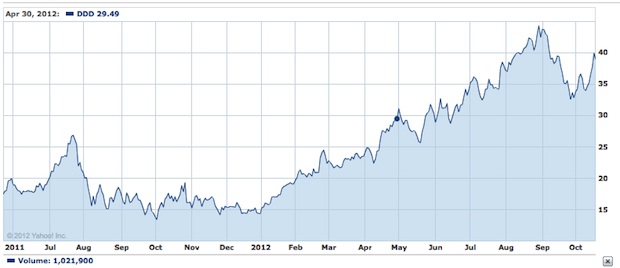There are vast opportunities for the 3D printing industry to grow exponentially in the next few years — indeed, in February of last year Business Insider suggested that it will be the next trillion dollar industry. As of today 3D printing is still in the early stages of its journey, but let’s take a look at the big picture in terms of where it is now and how things are progressing. There will be forward looking statements included.
Consumer Electronics Association (CEA) this week released a report noting 3D printing as one of the five technology trends to watch, along with next generation TVs and displays, the evolution of audio, the mobile revolution in Africa and the impact of technology within education.
Another significant indicator comes from Wohlers Associates and the orgainisation’s 2012 Additive Manufacturing and 3D Printing State of the Industry report predicted the growth for 3D printing and services to rise up to $3.7 billion Worldwide by 2015. The same report pronounced consumer products and electronics as the leading growth enabler for 3D printing firms, followed by the automotive and medical/dental sectors respectively.
The Deloitte report, published earlier this year, noted one of the drivers of growth for 3D printing is the entry-level price of systems, which are continuing to drop below $1,000 throughout 2012, allowing hobbyists and determined consumers to enter the market. The same report, however, was not so positive about the overhyped rapid 3D printing market growth concluding:
“While the technology has several unique applications and is expected to experience considerable growth in the long run, for the foreseeable future it will likely remain a specialized application that for the most part will complement, not replace, traditional forms of production.”
This could well be the case in the short to medium term, despite the growing hype around the technology and increasing consumption by early adopters. On the other hand, according to the Wohlers’ report the growth is rapid, even though the numbers may still seem small: in 2011 more than 23,000 personal 3D printers were sold, which represents 289.2% year-on-year growth.
The largest 3D printer manufacturers include companies such as 3D Systems (NYSE: DDD), Stratasys (NASDAQ: SSYS) and Optomec. Looking at the stock prices for the past five years for the first two (both publicly traded), it could be legitimately argued that the investor markets have bought into the hype?
While it remains to be seen how fast the World will embrace 3D printing technology, and in particular the rate at which consumer driven markets will adopt it, at this point, it cannot be denied that the 3D printing industry continues to grow fast.





